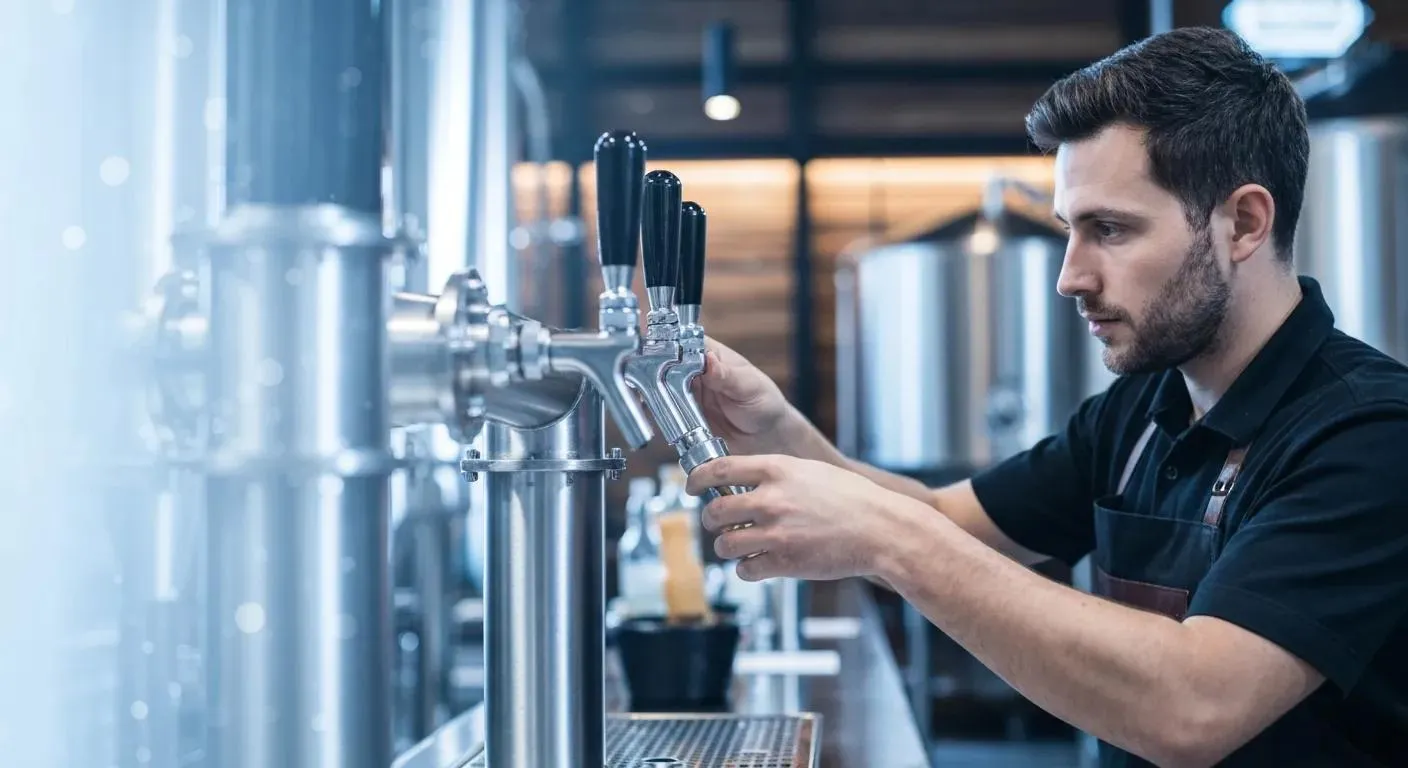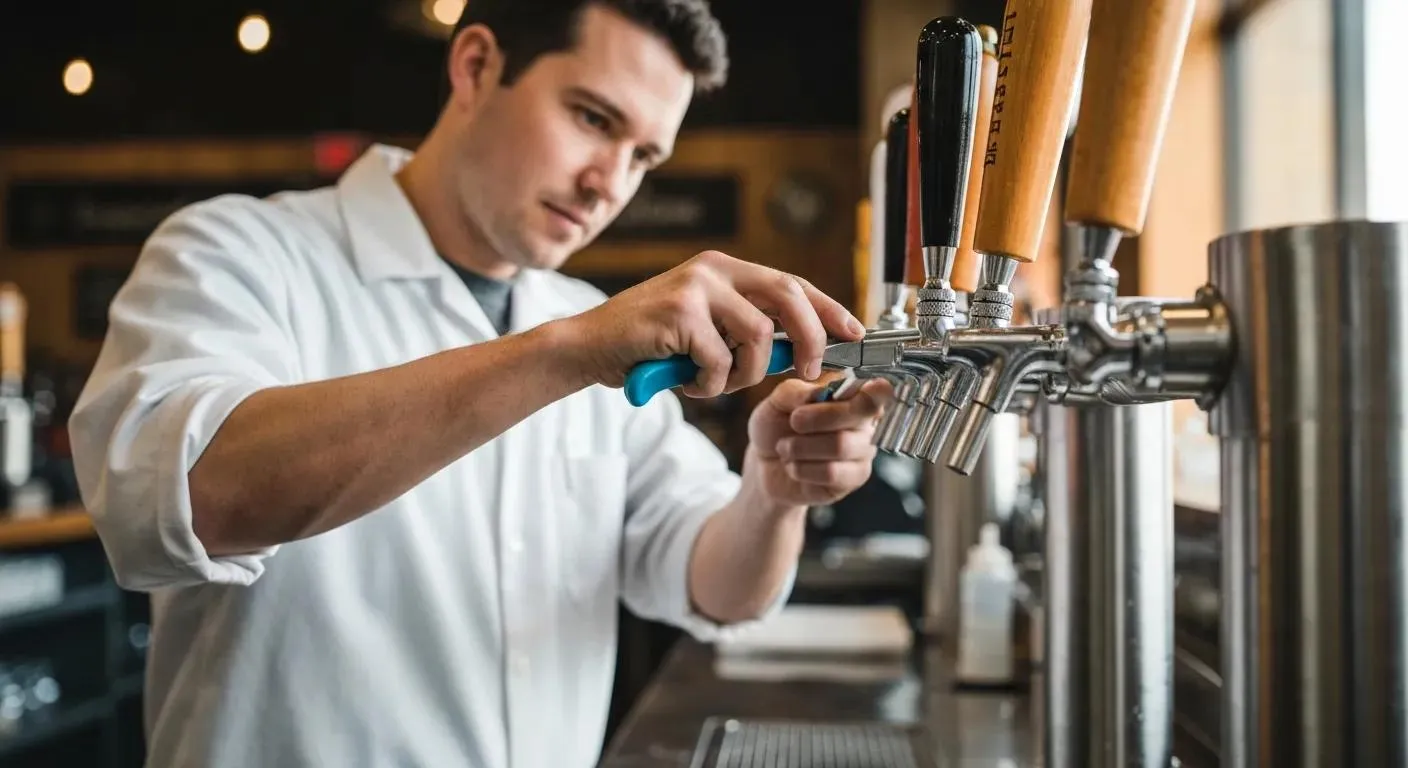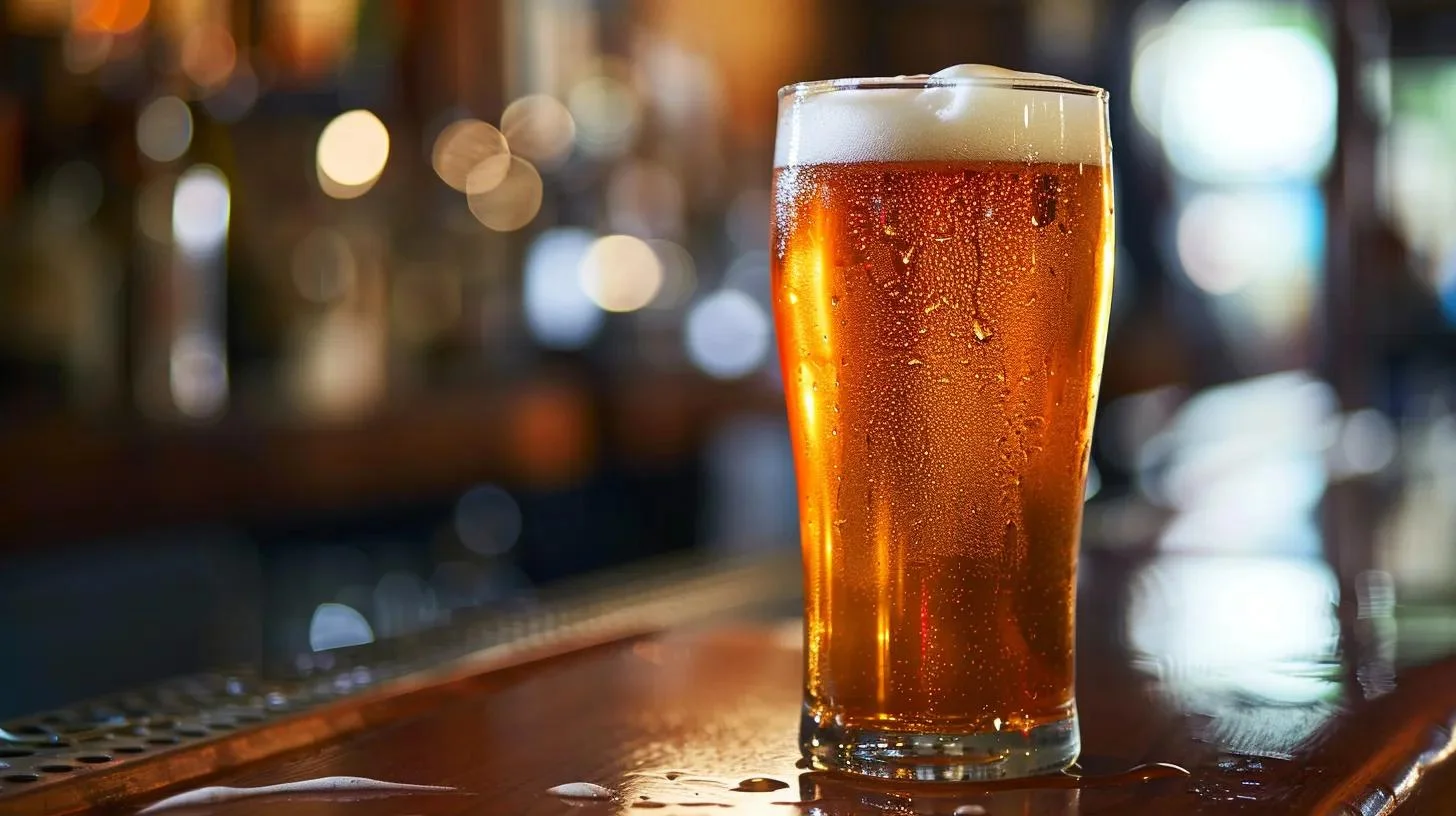Glycol System Beer Line Cooling: Essentials for Craft Breweries

Glycol systems for beer dispensing are an advanced solution for maintaining the optimal temperature of beer from the keg to the tap. These systems are crucial for establishments that need to serve beer at consistent temperatures over long distances. By utilizing a mixture of propylene glycol and water, these glycol beer systems prevent any rise in beer temperature as it travels through the lines. A glycol beer system is particularly useful for bars, restaurants, and pubs that aim to serve the freshest and coldest draft beer.
The backbone of a glycol system lies in its ability to provide a consistent cooling effect which ensures that the beer remains cold and refreshing until it reaches the customer. The use of food-grade propylene glycol is standard within every glycol draft system in the industry, ensuring both safety and efficacy in cooling. Professional installation and regular maintenance are essential for the optimal operation of these systems, and they can be customized to meet the specific needs of an establishment.
Key Takeaways
- Glycol systems ensure beer is dispensed at the ideal temperature.
- Food-grade propylene glycol is safe and effective for beer cooling.
- Customization and professional maintenance are key for system efficiency.
Fundamentals of Glycol Systems
In a glycol beer system, glycol's role in maintaining the ideal temperature is crucial for the quality of draft beer. This system employs glycol, a type of antifreeze, ensuring consistent cooling throughout the draft beer tower dispensing journey.
Importance of Glycol in Draft Beer Systems
Glycol, specifically propylene glycol, is an indispensable component in draft beer systems, providing the necessary temperature control. As a food-grade antifreeze, it delivers reliable chilling capabilities without affecting the beer's taste. This is essential for maintaining the draft beer at its optimal serving temperature, averting any risk of foaming or flavor alteration caused by temperature fluctuations.

Overview of Glycol Beer System Components
A typical glycol beer system consists of these essential components:
- Glycol Power Pack: The refrigeration unit that cools the propylene glycol mixture.
- Glycol Bath: A solution of water and glycol that removes heat from the beer lines.
- Insulated Beer Lines: Enables the cold glycol to run parallel to the beer lines, preventing heat gain.
- Trunk Line: An insulated conduit housing both glycol and beer lines.
- Faucet: The dispensing hardware where beer is poured.
These components work in tandem to ensure beer is delivered cool and refreshing from keg to glass.
The Role of Propylene Glycol
Propylene glycol plays a dual role in the system. First, it acts as a coolant with a low freezing point, enabling it to circulate in temperatures low enough to keep the beer cold without freezing itself. Second, it's safe for contact with consumables; its food-grade quality means it won't contaminate the beer, making it an ideal choice for such applications. Systems typically use a propylene glycol to water ratio of 35%-40% to maintain the desired chilling effect without becoming too viscous to pump.
System Components and Setup
The glycol beer system is a complex network of components working together to deliver a perfectly chilled mug of draft beer. Every part from the glycol chiller to the tap handle plays a critical role in maintaining the perfect serving temperature and ensuring the quality of the beer experience.
Understanding the Glycol Chiller
The glycol chiller is the central unit responsible for maintaining the required temperature in a draft beer system. It circulates a glycol and water mixture to absorb heat as the beer is transferred from the keg to the tap. An efficient glycol beer chiller also must be properly sized to match the length of the run and the number of taps in use, ensuring a consistent temperature throughout the system.

Keg and Keg Couplers
At the starting point of the system is the keg, a pressurized container housing the beer. Kegs connect to the system through keg couplers, which create a seal and permit the flow of beer and gas. The coupler types vary depending on the keg's brand and type; one must select the correct coupler to ensure compatibility and prevent leaks or service interruption.
Configuring Glycol Lines and Beer Towers
Optimally configuring the glycol lines is key in a long-draw beer system. These lines run from the chiller, parallel to the beer lines, within an insulated bundle often referred to as the trunk line.

Properly insulated glycol chiller lines prevent temperature fluctuations which can affect beer quality. At the point of dispense, the beer tower houses the taps through which the beer is served. When setting up beer towers, attention should be given to the coolant line and tap design, ensuring that they support consistent cooling and ease of use.
Temperature Control and Maintenance
Effective temperature control and maintenance of glycol decks are crucial in ensuring that beer served from a glycol system is at a perfectly chilled temperature which enhances flavor and customer satisfaction. It also prevents issues like foam and beer freezing that can arise from temperature mishandling.
Maintaining Optimal Beer Temperature
For serving beer that is consistently cold and palatable, the ideal glycol cooling system should maintain beer temperature within a narrow range. Alcoholic beverages ideally require a chiller setting of 27-29 degrees Fahrenheit. Non-alcoholic beverages, however, should be kept slightly warmer to prevent freezing of the drinks Chill Out: How To Maintain Your Glycol Cooled Draft Beer System. These temperature settings ensure that the beer is served at a perfectly chilled temperature without the risk of freezing.

Glycol System Cleaning and Upkeep
The maintenance of a glycol line system is crucial for its longevity and efficiency. Regular cleaning cycles should be conducted to prevent microbial growth and a build-up of beer stone in the lines. Glycol, a food-grade antifreeze, should be mixed properly with water to keep the system's glycol bath functional within the required 27-29 °F range necessary for optimal beer cooling Everything You Wanted To Know About Glycol.
Addressing Foam and Freezing Issues
Foam control is largely related to maintaining a consistent temperature within the glycol system. If the temperature is too high, it can lead to excessive foam and if the proper temperature is too low, it may cause the beer to freeze, resulting in product waste and customer dissatisfaction. The glycol system should be checked regularly to prevent these issues by ensuring the freezing point is correctly set for the beverage being dispensed, and by adjusting the system pressure and temperature settings as needed Glycol Beer System: The Ultimate Guide to Temperature Control in Draft Beer Dispensing.
Dispensing Technologies
In the context of draft beer systems, dispensing technologies are central to delivering a perfectly chilled pint. This section delves into the technical aspects of the trunkline and power pack mechanics cooled draft beer systems as well as the nuances of dispensing nitrogenated beers through gas blending.
Trunkline and Power Pack Dynamics
The trunk line serves as the critical channel through which beer flows from the keg to the tap. It typically houses several lines that carry beer, refrigerant, and sometimes gas. These lines are insulated to maintain the beer's temperature during transit. The glycol power pack, an essential component, keeps the glycol refrigerant circulating through all the equipment and trunk lines at a consistent temperature. This setup ensures that the beer remains cold from the keg to the glass, even over long distances.
Maintenance of the system, especially the trunk lines, is crucial as it directly impacts the beer's quality. Regular servicing reduces the likelihood of temperature fluctuations that can affect the beer's taste and freshness. Companies like KegWorks emphasize the importance of a well-maintained glycol system to prevent costly breakdowns.
Nitrogenated Beers and Gas Blending
When it comes to nitrogenated beers, an entirely different dispensing approach is necessary. These beers require a mix of nitrogen and CO2 to achieve the right level of carbonation and mouthfeel that typifies a smooth, creamy stout like Guinness. A gas blender ensures the correct proportion of gases, which is usually around a 75% nitrogen to 25% CO2 blend.
The precision of the gas mix is crucial—too much CO2, and the beer becomes overly fizzy; too much nitrogen, and the beer may appear flat. A consistent gas blend maintains the integrity of nitrogenated beers from the keg to the glass, presenting the consumer with the quality and experience intended by the brewer.

System Integration and Cost Factors
When considering the addition of a glycol beer system, one must be attentive to the implications long draw system for both existing establishments and the financial commitments involved. Implementing such a system carries with it various factors that can influence the overall expense and integration complexity.
Incorporating Into Existing Bars and Restaurants
Incorporating a glycol cooling system into existing bars and restaurants requires meticulous planning regarding space and infrastructure. The primary concern is the distance from the cooler to the tap, where a longer run can drive up installation costs due to increased materials and labor. Glycol systems stand as a preferred solution for maintaining the optimal temperature of draft beer, as it allows for long-draw systems which are often reflected in increased upfront costs. Bars may incur modifications to existing structures for accommodating glycol lines, potentially affecting the pour cost due to initial investment.
Analyzing the Cost of Installation and Operation
The cost of installation for a glycol draft beer system can vary widely, determined by factors such as the length of the run and the complexity of the system. Operators can expect to pay for components—like the glycol chiller, trunk lines, and faucets—as well as for labor, which can add up significantly.

Nevertheless, this investment is often justified by smoother operations and reduced maintenance demands. Ongoing operation costs stem from electricity to power the glycol beer chiller unit and glycol replenishment, but these are usually offset by efficiency and reduced beer waste. Considering the installation and operation costs against the expected lifespan and performance of the system provides a broader understanding of its value proposition.
Long-Distance Draft Beer Solutions
In establishments where the distance between the keg and tap is significant walk in cooler than, maintaining the beer's optimal temperature is a challenge efficiently met by glycol-cooled systems.
Long-Draw Dispensing Systems
Long-draw dispensing systems are the answer to serving cold beer over long distances. These systems typically include a glycol trunk line and rely on a mixture of water and propylene glycol to ensure that the beer remains at a consistent temperature from the cooler to the faucet. This method is highly effective for routes that extend upwards of 25 feet and is often employed in commercial settings. The use of glycol-cooled technology within these systems allows beer to travel significant distances without any loss in quality.
Insulation and Temperature Consistency
Ensuring temperature consistency in long-draw beer systems is crucial to prevent the beer from warming, which can lead to over-foaming and taste degradation. This is where foam insulation plays a pivotal role. By wrapping the glycol trunk line with sufficient insulation, the cold temperature is maintained throughout the beer's journey. Micro Matic is an example of a brand that offers glycol-cooled beer dispensing systems, which employ advanced technology for reliable temperature control. These systems can push beer even well over 100 feet while keeping it cold, using robust insulation and effective circulation of chilled glycol.
Troubleshooting and Professional Support
Glycol cooling systems are sophisticated mechanisms vital to maintaining the perfect temperature for draft beer. When these systems encounter issues such as inconsistent cooling or excessive foam, it's essential to address them promptly. This section provides a guide for identifying common problems and knowing when to seek the expertise of draft beer specialists.
Common Glycol System Problems
- Inconsistent Beer Temperature: A properly functioning glycol system is crucial for serving beer at the ideal temperature. If the beer is pouring warmer than usual, check the glycol chiller power packs to ensure they are not overloaded and the glycol mixture for proper concentration and flow.
- Excessive Foam: Too much foam can be caused by several factors including temperature fluctuations or pressure issues within the glycol cooling systems. Regular maintenance and checks of the system's balance can prevent foam problems.

When these common issues arise, owners should perform routine inspections and minor troubleshooting, such as verifying that the glycol bath cover is properly sealed or assessing the system's temperature settings.
When to Call in Draft Beer Specialists
- Complex System Issues: If basic troubleshooting does not resolve the issues, it may indicate a more complex problem that requires a professional's touch. Draft beer specialists have the experience and tools to diagnose and fix intricate system malfunctions.
- Installation and Maintenance Support: It's recommended to consult with installers or qualified technicians for glycol system installations, significant repairs, or comprehensive maintenance. They ensure the system operates efficiently and complies with the required standards.
- Regular System Servicing: To avoid the majority of glycol system complications, it's advisable to have draft beer specialists conduct periodic servicing and maintenance. This can help maintain the quality of draft beer and the longevity of the equipment.
Seeking professional support for advanced troubleshooting and maintenance not only ensures the issue is correctly identified and rectified but also prolongs the life of the glycol cooling systems, guaranteeing the best quality draft beer for consumers.
Conclusion
A glycol system for beer is a significant advancement in maintaining optimal temperature control in commercial draft beer systems. Compared to traditional air-cooled draft systems, glycol-cooled draft beer systems offer several advantages. These systems utilize a food-grade antifreeze—glycol—to keep the beer lines at a consistent temperature, ensuring that beer is dispensed at the ideal temperature.
Glycol cooled draft systems are particularly useful in scenarios where there is a long distance between the keg and the tap. They reduce the likelihood of temperature fluctuations, which can affect the taste and quality of the beer. Maintenance plays a crucial role in the longevity of quality glycol chillers in these systems, including regular checks and cleaning of all components.
Key considerations for selecting a draft system include:
- Distance from the cooling source to the taps
- Budget for installation and maintenance
- Type and volume of beer being dispensed
In summary, choosing a glycol system for beer dispensing is beneficial for establishments that prioritize serving beer at its best. While the initial investment might be higher than that of an air-cooled system, the quality and consistency of the beverage served can enhance customer satisfaction and, ultimately, the establishment's reputation.
For more questions about glycol cooling systems or draft beer systems please reach out to us at Renny's Draft Solutions Cheers!



